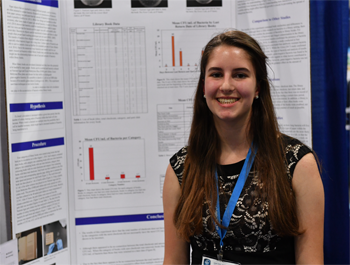Library books could come with a side of germs
A bookworm did an experiment to discover how many bacteria build up on books

Could library books be hiding bacteria? A teen did an experiment to find out.
Wavebreakmedia/istockphoto
LOS ANGELES, Calif., — There’s a lot to love about libraries. But could those thousands of free books be harboring bacteria? Cheyenne Deibert, 16, created a science fair project to find out. Her results will make book lovers heave a sigh of relief — most tomes are perfectly clear. She also showed that when it comes to microbes, it’s not how many times a book gets checked out, it’s how recently that book has been handled.
The sophomore at Clarksville Academy in Tennessee brought her results here, to the Intel International Science and Engineering Fair (ISEF). Created by Society for Science & the Public and sponsored by Intel, the competition this year brought together nearly 1,800 students from more than 75 countries to show off their winning science fair projects. (The Society also publishes Science News for Students and this blog).
Cheyenne admits she’s a real bookworm. But reading while home sick, she began to see her books in a different light. “If I’m reading these while I’m sick, there’s bacteria all over,” she recalls thinking. “I’m touching these library books, passing them from person to person. Do they have bacteria?” She knew that germs could end up on items that are handled frequently, such as money. The teen decided to test her suspicions that books may too. And she did it with an experiment.

With the help of local librarians, the teen collected 12 books that had been published on or after August 1, 2016. They included Amy Schumer’s The Girl with the Lower Back Tattoo, Mary Roach’s Grunt: The Curious Science of Humans at War and Beth Harbison’s Show Addicts Anonymous. The teen aimed for books that were about the same size and could be found in the “popular” section. She wanted “books people would actually read [and touch a lot], as opposed to looking at page 300 for a reference,” she explains.
She sorted the books by how often they had been checked out — zero, one, two and three times. Cheyenne hypothesized that books that were checked out more often would host more bacteria.
The teen carefully swabbed the first page of the first chapter of each book as well as the blank page opposite to it. She then rubbed her swabs on four petri dishes per book. Two of the petri dishes contained only agar — a gellike substance many bacteria like to eat. The other half contained agar with methylene blue. This chemical inhibits the growth of some species of bacteria but encourages others. It helped Cheyenne determine if certain species that might be harmful were present, such as E. coli.
To keep the dishes near body temperature (around 37° Celsius or 98.6° Fahrenheit), Cheyenne put them in an oven for 47 hours. Then she took the plates out and counted how many bacterial colonies she could see.
Of the 12 books, seven grew no bacteria at all. With the five that did grow germs, the teen found that her hypothesis had not been right: The number of times a book had been checked out didn’t seem to affect how many microbes were present.
What she found
Cheyenne looked at the number of days between when a book had last been returned to the library and when she started her experiment. Those sitting in the library for only three days tended to have more bacteria than those that had last been returned 20 days before her tests, the teen found. This makes sense, she notes. If a book is sitting around untouched, the bacteria in its pages might die off. And with no new readers, new bacteria are not being added. But if the tome had been checked out recently, microbes might still be hanging out.
Overall, not many microbes showed up on the books she tested. None of the swabs transferred E. coli to the dishes. The teen compared her findings to results from scientific papers on library-book bacteria. The authors of those papers found bacteria and fungi on library books, and some of those germs might be resistant to antibiotic drugs. But like Cheyenne, they didn’t find high levels of microbes. They also concluded that fungi (such as molds) were probably more worrisome than bacteria. Mold can be harmful for people with lung problems such as asthma and cause disease in people with weak immune systems.
That’s not the end of Cheyenne’s investigations. The teen now would like to look into how long bacteria from someone’s hand might survive on a book’s pages, and if there are more microbes at different times of year.
For now, her data indicate, librarians (and book lovers) don’t have much to worry about. Cheyenne notes, however, that she does wash her hands after reading. Just in case.
Follow Eureka! Lab on Twitter







